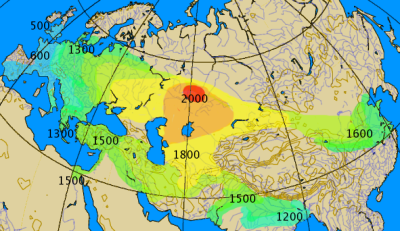MOESAN
Elite member
- Messages
- 5,895
- Reaction score
- 1,299
- Points
- 113
- Location
- Brittany
- Ethnic group
- more celtic
- Y-DNA haplogroup
- R1b - L21/S145*
- mtDNA haplogroup
- H3c
Concerning pops, I argued concerning sedentary pops of S-E Europe compared to Yamnaya steppic pops (already herders) - I did not compare Steppic HGs to subsequent pops newly arrived into their homelands. Sure, there have been big changes since the HGs world: farmers come from South (which South?: surely Balkans as well as South Caucasus, even if I suppose Balkans weighted more at the first step). An-AuDNA and mtDNA for Yamnaya Samara show an (or several) imput(s) from more Southern pops into the Steppes, uneasy to date (Neolithic + Bronze, perhaps at Copper) and it's difficult to distinguish between old and new. So, yes, surely a demographic increase before Yamnaya.
I agree Catacombs which were more sedentary could have had a more important imput concerning language but even the Catacombs complex is under debates: metrics found two partly different pops of catacombs (I've not the detail helas) as there were two partly different kinds of Pit Graves people (Kalmykia vs others). Catacombs seems being under influence of Iran cultures according to Grigoryev but, spite its status of less mobile people, it shows (in some places at least) having an mtDNA more Steppic less Southern. So we have metallurgy beginning among Yamnaya rather by East towards West, and Catacombs whose females seem showing an East to West travel too... puzzling. And to complicate things, Maykop seems more an exception than a typical local pop, even compared to West Caucasus. ? A "syndicat" of rich traders-warriors of diverse origin sharing their skills and living at the depends of a less evolved local pop? In older compilations I red Maykop culture was not producing so much metal locally and their barbaric richness was closer to spoils or "muscled trade" than something else.
I agree Catacombs which were more sedentary could have had a more important imput concerning language but even the Catacombs complex is under debates: metrics found two partly different pops of catacombs (I've not the detail helas) as there were two partly different kinds of Pit Graves people (Kalmykia vs others). Catacombs seems being under influence of Iran cultures according to Grigoryev but, spite its status of less mobile people, it shows (in some places at least) having an mtDNA more Steppic less Southern. So we have metallurgy beginning among Yamnaya rather by East towards West, and Catacombs whose females seem showing an East to West travel too... puzzling. And to complicate things, Maykop seems more an exception than a typical local pop, even compared to West Caucasus. ? A "syndicat" of rich traders-warriors of diverse origin sharing their skills and living at the depends of a less evolved local pop? In older compilations I red Maykop culture was not producing so much metal locally and their barbaric richness was closer to spoils or "muscled trade" than something else.



